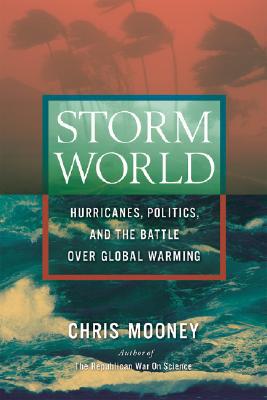

| STORM WORLD Hurricanes, Politics, and the Battle over Global Warming Chris Mooney New York: Harcourt, Inc., July 2007 |
Rating: 5.0 High |
|||
| ISBN-13 978-0-15-101287-9 | ||||
| ISBN-10 0-15-101287-3 | 392p. | HC/GSI | $26.00 | |
This book begins with an important caution, citing the climate science blog RealClimate1 on the crucial distinction between weather and climate, which many overlook for one reason or another. In particular, it is appropriately cautious with respect to whether or not the features of a given storm (strength, duration, etc.) can be attributed to global warming, a question that still has not been definitively answered.
"To explain the difference between weather and climate, RealClimate.org used the analogy of rolling a die: You never know what's going to come up on any given roll, but over time and across many rolls, you can get a very good sense of the odds (and thus, whether or not the die is loaded.)" – Page 4 |
In other words, whether or not a particular storm would have been weaker without the presence of AGW cannot be determined, but observations are beginning to detect a trend.
In addition to having value as a history of hurricane behavior and of the development of study of hurricanes, this book sheds significant light on the continuing controversy over whether global warming is real. (Though "controversy" is the wrong word in this case, because it implies at least some validity on both sides of the question.) In particular, it demonstrates the sharp difference in behavior between those who accept the scientific evidence and their adversaries; the adversaries behave with much more hostility, often condemning not only the scientific conclusions of what they call the consensus, but the scientists who are its members.For example, there was the contretemps between William Gray and Kerry Emanuel at the biennial conference on Hurricanes and Tropical Meteorology, held by the American Meteorological Society in 2000. Gray collected empirical hurricane data; Emanuel was developing a theoretical framework for hurricanes. Here's a fragment of Gray's contribution to the "debate":
"In the recollection of many scientists present, however, it wound up being something of a circus. Gray called Emanuel's attention to thermodynamics a 'fixation.' He said Emanuel was 'playing games.' He even likened his fellow scientist to a salesman. 'He could sell ice cubes to the Eskimos and steam heat to the Amazonians,' Gray declared at one point. The audience chuckled, but this is not how scientific debates are supposed to go down.' It was sort of like a Kerry Emanuel roast, making fun of me personally,' Emanuel remembers. 'It was a humorous sort of thing that didn't bring in any science.' " – Page 100 |
Gray continued to display this condemnatory attitude toward theoretical treatments of weather phenomena, and especially toward global warming. Even in hearings before Congress, he was unrestrained.2 Mooney uncovers additional details of how NOAA (primarily) and NASA impeded contact between their scientists and the press. This often amounted to suppression, because the reporters could not tolerate the delays inherent in the process of getting permission to speak; they simply stopped asking for interviews.3
"The year was 2006. The human fingerprint on the current global warming trend had been conclusively detected by the world's scientific community. Consensus had been achieved among the vast majority of experts studying the issue. Yet in Gray's audience sat some of the nation's leading hurricane forecasters and emergency planners, who were hearing a very different message—and at least some of whom seemed to be soaking it up like Florida sunshine." – Page 104 |
Mooney's account is even-handed; he frequently points out the contributions of the data collectors, among which Gray is noteworthy. He was among the first to ride "hurricane-chaser" airplanes to collect data, and has developed important insights from these observations.4 At the same time, his criticisms of theoretical work are frequently unsound, and like many who doubt global warming, he often resorts to ad hominem attacks. Theorists like Emanuel and Kevin Trendberth and modelers like Thomas Knutson of GFDL have also made valuable contributions, adding up to a growing body of evidence that warmer oceans mean bigger, stronger, and more frequent cyclonic storms — if they don't uniformly display all these characteristics at the same time.
"For despite Gray's and Michael Crichton's sneering at scientific 'consensus,' it's really all we have—we laypersons, we journalists, we politicians— to go on. We watch scientists battle, and no matter how much of their debates we think we understand, if we're honest we know they're always a little bit ahead of us, knowing a little bit (or a lot) more. We can't presume to reliably guess which scientist is right and which is wrong as it all unfolds in real time. That would be the height of arrogance and foolishness. We can't pick winners—not unless the broader scientific process, in which they all participate, pulls them (or the bulk of them) together in a conclusion they strongly and collectively accept. On global warming itself, that has happened already. On global warming and hurricanes, it hasn't yet." – Page 258 |
It is well researched through interviews and attendance at conferences. There are four appendices, extensive endnotes, a "Bibliography and Recommended Reading" with 83 entries (though I found no trace of recommendation), a List of Interviews, and an excellent index
There are a few lapses. For example, Mooney discusses the contribution of the Finnish scientist Erik Palmén (1898-1985) to the thermodynamics of hurricane formation, but immediately thereafter (page 40) says — without explaining how — that ""Thanks to Palmén's paper, scientists now knew of the importance of easterly waves..."

 To contact Chris Winter, send email to this address.
To contact Chris Winter, send email to this address.